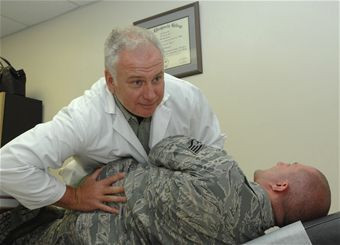Osteopathic Manipulation Reduces Chronic Lower-Back Pain -- With A Little Help From Painkillers

Osteopathic manipulation might reduce pain symptoms for the millions who suffer from chronic lower back pain, a new study demonstrates.
While no panacea for the second-most common neurological problem after headaches, the treatment helps in combination with the usual painkillers. The outpatient care involves manipulating joints back into place, relaxing overused muscles and massaging the soft tissue, according to Dr. John Licciardone, an osteopathic specialist who led the study.
"I think the osteopathic approach is different [from chiropractic care] in that it takes a more overarching view, so you wouldn't necessarily restrict your examination or treatment to the lower back," said Licciardone, who is based at the University of North Texas Health Science Center.
In the study, the research team treated a study and control group composed of 455 people suffering chronic lower-back pain, for six sessions over a period of eight weeks. The team checked the study group three weeks following the completion of treatment, finding that 63 percent reported moderate improvement with half reporting significant improvement. In the control group, 46 percent reported moderate improvement with 35 percent reporting significant alleviation of pain symptoms.
The researchers also studied the use of ultrasound therapy, which failed to produce any benefit. However, neither treatment studied here yielded improved functioning of the lower back, an outcome that remains stubbornly beyond the reach of modern medicine.
The typical osteopathic manipulation session costs consumers approximately $100, a charge that might not be covered by health insurers but which sufferers may nevertheless consider worth the cost -- especially those who've already tried painkillers and physical therapy.
A typical osteopathic manipulation session costs about $100, and may or may not be covered by insurance. That may be worth it, Licciardone said, for people who have already tried over-the-counter painkillers and physical therapy and are running out of non-invasive options.
"We saw the biggest reduction in pain in the people who had more severe pain to begin with, and those are the people who are going to be more likely looking for the more costly and more invasive treatments," he said.
Dr. Timothy Carey, a osteopathic expert from the University of North Carolina at Chapel Hill, was not involved in the study.
"The consensus on most of those studies, I think, is that spinal manipulative therapy is better than no treatment and has a modest benefit over a period of time, but is not substantially better than other types of treatment including pain medications [and] exercise recommendations," he told Reuters.
Osteopathic manipulation may provide a good complimentary treatment for patients, in conjunction with painkillers, he said.
The study was funded by the U.S. National Institutes of Health's National Center for Complementary and Alternative Medicine and the Osteopathic Heritage Foundation. The National Institute of Neurological Disorders and Stroke, too, is researching new treatments for lower back pain, studying a half-different painkillers in additon to surgical and radiological treatments.
Back pain affects approximately two-thirds of American adults and is the leading cause of disability in people 45 and younger.



























